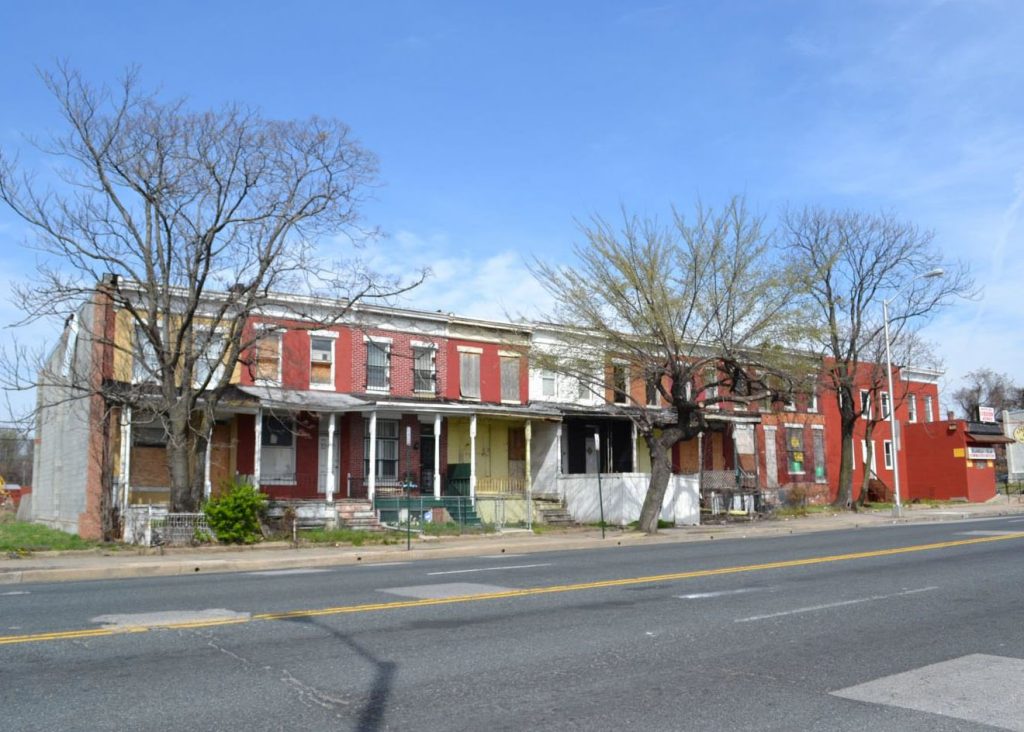Last month, Baltimore Heritage and Preservation Maryland proposed a strategy to mitigate the loss of historic rowhouses under Project CORE. Our proposal focuses on:
- stabilizing historic buildings that can be saved and reused,
- supporting nonprofit and local government staff positions to guide the implementation the project,
- and documenting the buildings selected for demolition.

Baltimore Heritage and Preservation Maryland, along with our nonprofit partner, the Baltimore National Heritage Area, recently presented our proposal to city and state agencies as part of the ongoing preservation review of Governor Hogan’s Project CORE (Creating Opportunities for Renewal and Enterprise).
As we shared last month, CORE provides around $75 million in state funds for demolishing and stabilizing vacant buildings in Baltimore over four years. The Maryland Department of Housing and Community Development and Baltimore Housing have agreed that 10% of the Project C.O.R.E. funding should go to mitigating the loss of rowhouses proposed for demolition inside designated historic districts.
The joint mitigation proposal by Preservation Maryland and Baltimore Heritage and supported by the Baltimore National Heritage Area has three basic components.
- Stabilization: The proposal calls for the lion’s share of the mitigation funds to be spent on stabilizing historic buildings. Part of the funds would go to the city’s Vacants to Value Program to shore up city-owned vacant rowhouses and offer them for sale to new private owners. Another part would go to a new grant program at Preservation Maryland. The program would support the stabilization of historic buildings as a strategic investment in broader revitalization efforts.
- Staff Assistance: The proposal also calls for a small part of the mitigation funds to be spent on a staff position, based jointly at Baltimore Heritage and Preservation Maryland, to focus on vacant housing issues within historic neighborhoods. This funding would implement a key recommendation from the 2014 study of Baltimore by the Partnership for Building Reuse calling for more staff at preservation nonprofits to expand existing programs and partnerships around vacant and underutilized buildings. The proposed new position would complement a new position at the Baltimore Department of Housing and Community Development that would similarly focus on implementing Project C.O.R.E. and vacant housing issues more broadly.
- Survey and Documentation: The final component of the proposal would give another small portion of the mitigation funds to document the historic buildings that would be demolished and survey historic neighborhoods in the city to assess the impact of the demolition. Funds could also be used to help neighborhoods prepare applications to become designated historic districts, a designation that helps them preserve their heritage and provides financial incentives for rehabilitation work through city and state historic tax credits.
The state Department of Housing and Community Development, the lead agency in Project C.O.R.E., is reviewing the joint mitigation proposal by Baltimore Heritage and Preservation Maryland. The agency is planning to begin demolition work this summer and we expect to receive a response to our proposal soon.



The problem is that many, many large cities (Baltimore, Philadelphia, Cleveland, etc.) seem to have not learned that you cannot bulldoze your way out of blight into revitalization. You simply exchange unmaintained vacant buildings for unmaintained vacant lots. The presence of so many rowhouses targeted for demolition in historic districts is very troubling, since (I am assuming these are National Register districts), tax credits that are available for the restoration of said rowhouses will not be available for their replacements. That will increase the cost of neighborhood reinvestment, since restoring a historic rowhouse (with tax credits) is less expensive than constructing a new rowhouse. All of that also ignores the aesthetic and historical degradation caused by demolition. This is merely the return of government-enacted Urban Renewal with the mantra “Old buildings are blighted and if we spend large sums of money to get rid of them, the city will be improved.”
Some of these old vacant rowhouses are too deteriorated to be repaired and reused. Since Baltimore like most other older northern US cities has problems with urban decay and abandonment along with violent crime especially drug gangs that use these vacant decrepit buildings for their drug dealing operations, demolition and clearance ends up being the only viable answer. A vacant lot is a lot safer than a vacant decrepit building that nobody wants. Baltimore is wise in demolishing these decrepit rowhouses especially the fire gutted ones.